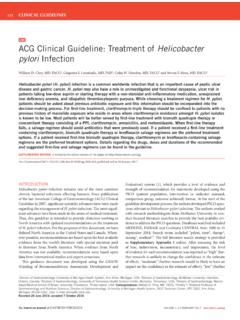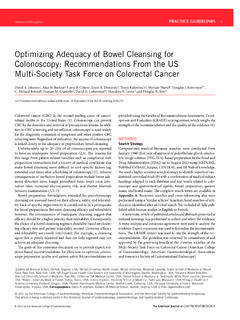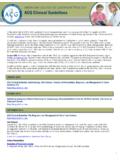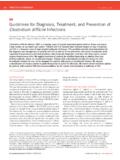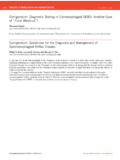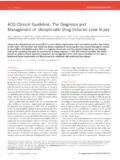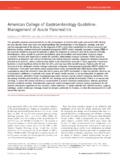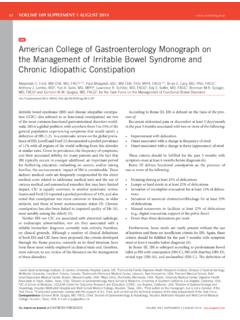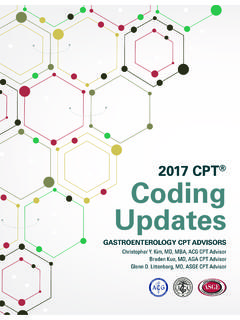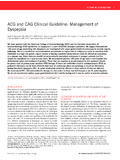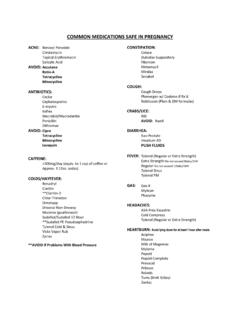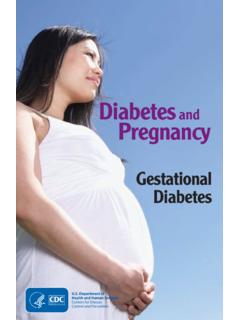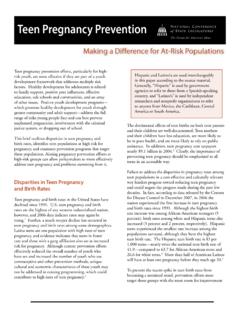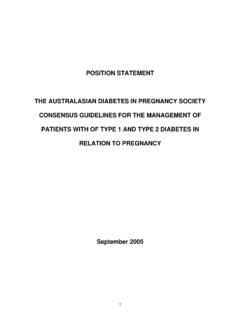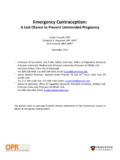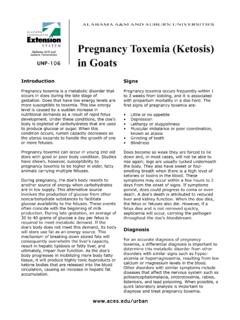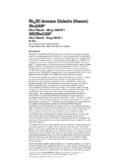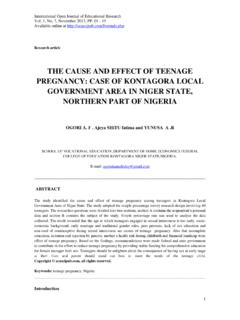Transcription of ACG Clinical Guideline: Liver Disease and Pregnancy
1 Nature publishing group1 2016 by the American College of Gastroenterology The American Journal of GASTROENTEROLOGYPRACTICE GUIDELINESTo determine the level of evidence, the results from the selected papers with the greatest level of evidence were extrapolated and utilized in the GRADE program ( ). A summary of the recommendations are outlined in Table 1 . EVALUATION OF THE PREGNANT PATIENT WITH ABNORMAL Liver ENZYMES Recommendations: 1. A pregnant patient presenting with abnormal Liver tests should undergo standard workup as with any non-pregnant individual (strong recommendation, very low level of evidence). Th e basis for the workup of abnormal Liver tests in a pregnant woman should be predicated on understanding the normal physi-ological changes observed during Pregnancy .
2 Th e incidence of abnormal Liver tests in pregnant women is ~3 5%, even in this relatively young and healthy population. Some Liver test results, which would otherwise suggest Liver or biliary dys-function in the non-pregnant individual may in fact be normal in the pregnant woman. Conversely, abnormal test results should be appropriately evaluated as some diseases newly diagnosed in preg-nancy may require more immediate intervention for the mother or the neonate ( , herpes hepatitis, hepatitis B; Ta b l e 2 ) Generally, the majority of Liver tests remain in the normal range in Pregnancy except those produced by the placenta (alkaline phosphatase, alphafetoprotein) or impacted as a result of hemodilution (albumin, hemoglobin).
3 Of note, during Pregnancy , cardiac output is increased by 40 45% with substantive increases to the renal, uterine, and skin systems. However, the Liver blood fl ow shows little change during Pregnancy , suggesting a relative decrease of total percent of cardiac output ( 3 ). Any abnormality seen in trans aminases and bilirubin needs further evaluation ( Figure 1 ). Management of pregnant women with Liver Disease is a common Clinical scenario, and one that can be challenging given the need to consider not only the expectant mother, but also the unborn fetus in treatment decisions. Th e purpose of this guideline is to provide a review of the diagnostic and treatment challenges of managing Liver Disease in pregnant women.
4 Th e evidence behind approaches to diagnosis and treatment of Liver Disease in pregnant women are assessed to provide management recommendations. Th ese recommendations are based on the following: (i) a search and review with analysis of the recently published world literature on the topic using Medline search from 1946 to present, EMBASE 1988 to present, and SCOPUS from 1980 to present using the search terms listed in the Appendix . (ii) Guideline policies of the ACG. Intended for use by physicians and allied health profession-als, these recommendations suggest preferred approaches to the diagnostic, therapeutic, and preventive aspects of care. Th ese are intended to be fl exible and adjustable for individual patients ( 1 ).
5 To best characterize the evidence cited in support of the recom-mendations, the ACG practice guidelines have implemented the use of the Grading of Recommendation Assessment, Develop-ment, and Evaluation (GRADE) system. Th e strength of recom-mendations in the GRADE system is classifi ed as strong (when the positive eff ects of an intervention or recommendation clearly are greater than the negative eff ects) or conditional (when there is uncertainty regarding the positive vs. negative aspects of the recom mendation) ( 2 ). Th e quality of evidence supporting strong or conditional recommendations is designated by one of four lev-els: high (suggesting that further research is unlikely to change the authors confi dence in the estimate of eff ect), moderate (fur-ther research would be anticipated to have an impact on the con-fi dence in the estimate of eff ect), low quality (further research would be anticipated to have an important impact on the confi -dence in the estimate of the eff ect and also likely change the esti-mate), or very low quality (the estimate of eff ect is uncertain) ( 2 ).
6 ACG Clinical Guideline: Liver Disease and Pregnancy T r a m T . T r a n , M D , F A C G , F A A S L D 1 , Joseph Ahn , MD, MS, FACG 2 and Nancy S. Reau , MD, FAASLD, FAGA 3 Consultation for Liver Disease in pregnant women is a common and oftentimes vexing Clinical consultation for the gastroenterologist. The challenge lies in the need to consider the safety of both the expectant mother and the unborn fetus in the Clinical management decisions. This practice guideline provides an evidence-based approach to common diagnostic and treatment challenges of Liver Disease in pregnant women.
7 Am J Gastroenterol advance online publication, 2 February 2016; doi: 1 Department of Medicine, Liver Transplant, Cedars Sinai Medical Center , Los Angeles , California , USA ; 2 Department of Medicine, Oregon Health & Science University , Portland , Oregon , USA and 3 Department of Medicine, Rush University , Chicago , Illinois , USA . Correspondence: Tram T. Tran, MD, FACG, FAASLD, Department of Medicine, Liver Transplant, Cedars Sinai Medical Center , Los Angeles , California 90048 , USA . E-mail: Received 7 September 2015 ; accepted 17 December 2015 Tran et al. The American Journal of GASTROENTEROLOGY VOLUME XXX | XXX 2016 2 Table 1.
8 Recommendation statements Initial evaluation of pregnant patient A pregnant patient presenting with abnormal Liver tests should undergo standard workup as with any non-pregnant individual (strong recommendation, very low level of evidence). Imaging in Pregnancy Ultrasound is safe and the preferred imaging modality used in assessment of abnormal Liver tests suggestive of biliary tract Disease (strong recommenda-tion, low level of evidence). Magnetic resonance imaging without gadolinium can be used in the second and third trimester (conditional recommendation, low level of evidence). Computed tomography scans carry a risk of teratogenesis and childhood hematologic malignancies but may be used judiciously with minimized radiation protocols (2 5 rads; conditional recommendation, very low level of evidence).
9 Endoscopy in Pregnancy Endoscopy is safe in Pregnancy but should be deferred until the second trimester if possible (strong recommendation, low level of evidence). Meperidine and propofol can be used for endoscopic sedation (strong recommendation, moderate level of evidence). Management of biliary Disease in Pregnancy ERCP can be performed when indicated for pregnant women presenting with biliary Disease that strongly necessitates intervention such as biliary pancreatitis, symptomatic choledocholithiasis, and/or cholangitis. Minimizing fetal exposure to fl uoroscopy is imperative (strong recommendation, low level of evidence). Symptomatic cholecystitis should be managed with early surgical intervention with laparoscopic cholecystectomy (strong recommendation, low level of evidence).
10 Liver masses in Pregnancy Asymptomatic hemangioma and focal nodular hyperplasia do not need routine imaging or surveillance during Pregnancy (strong recommendation, very low level evidence). Hepatic adenomas should be monitored with ultrasound during Pregnancy for growth. Patients with large adenomas (>5 cm) should be referred for resec-tion prior to Pregnancy (strong recommendation, low level of evidence). Hepatitis B in Pregnancy Active passive immunoprophylaxis with hepatitis B immunoglobulin and the HBV vaccination series should be administered to all infants born to HBV-infected mothers to prevent perinatal transmission (strong recommendation, low level of evidence). Women chronically infected with HBV and high viral load (>10 6 log copies/ml (200,000 IU/ml) and higher) should be offered antiviral medication with teno-fovir or telbivudine in the third trimester to reduce perinatal transmission of HBV (strong recommendation, low level of evidence).
